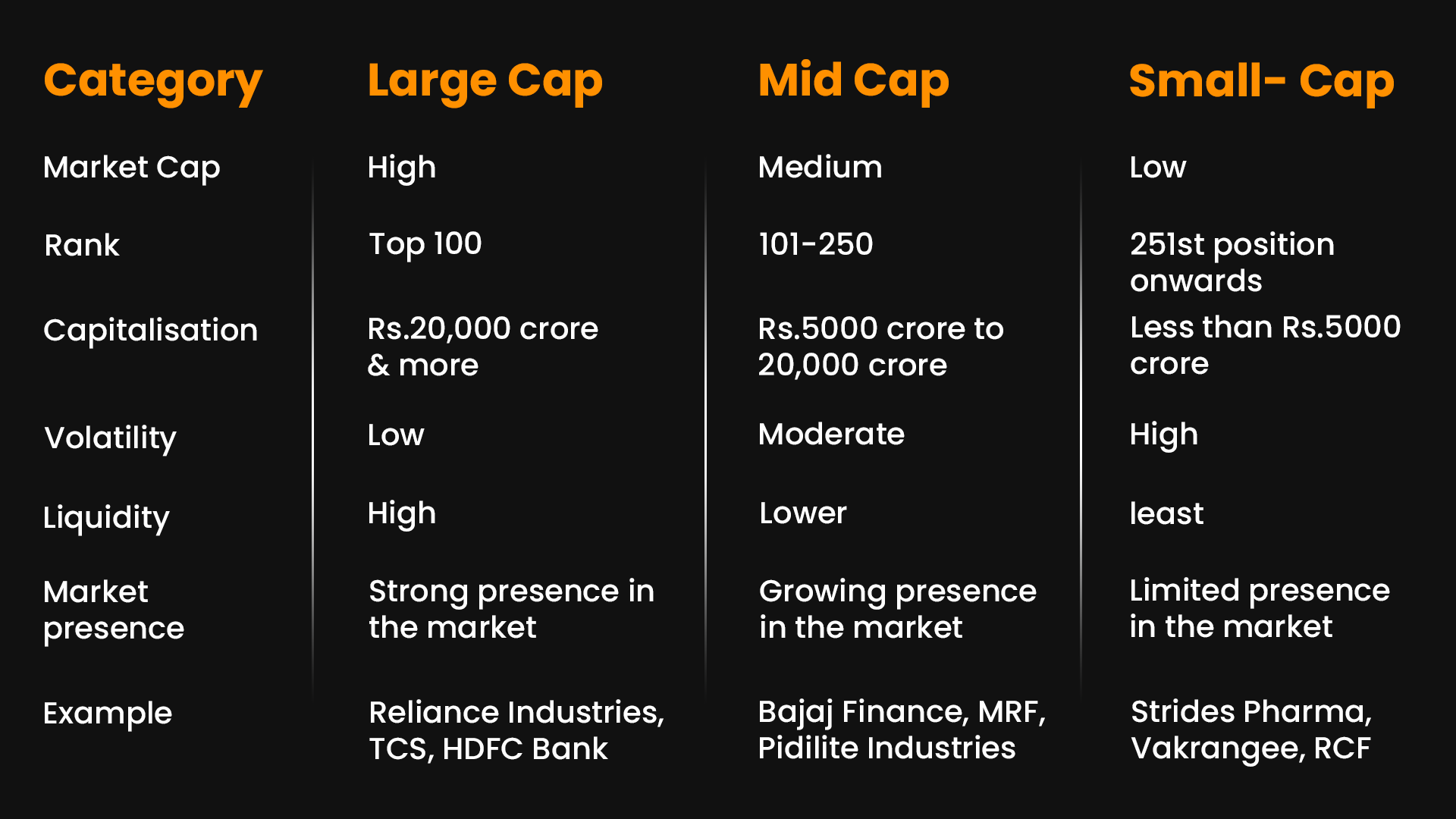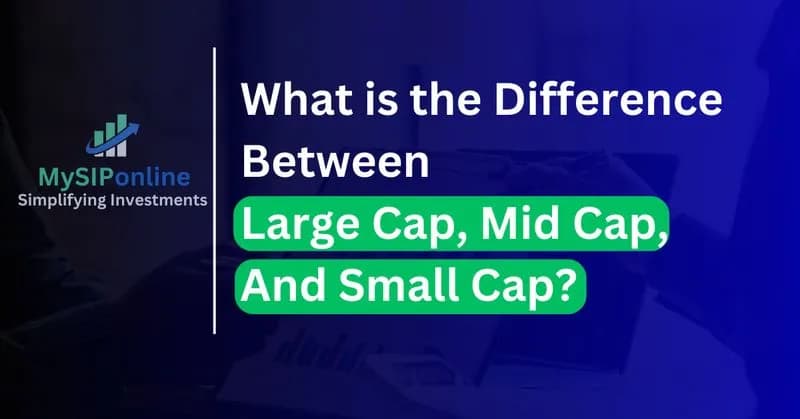Table Of Content
A Mutual Fund is a kind of investment option that is created by an asset management company [AMC] that collects money in the specific fund from numerous investors and utilizes that money to buy a diverse portfolio of stocks, bonds, or other securities. It is managed by an experienced fund manager whose goal is to earn good returns on investments so that they can make wealth for their client
Whether you're new to investing or have been doing it for some time, it's essential to understand market capitalization and the stock market. Knowing these concepts can help you make wise decisions on where to invest your money. With this knowledge, you can handle the complex aspects of finance and achieve your investment objectives.
In this blog, we will understand the market capitalization, large, mid, and small-cap, and also explore which cap is best for SIP suited for you.
What is Market Capitalisation?
Market capitalization is the total value of all the shares owned by a company's shareholders. In simple terms, market capitalization is a way to figure out how much a company is worth. It's calculated by multiplying the total number of shares of the company that people own with the current price of each share. This gives us an estimate of the company's overall value.
The three types of Market capitalization are-
- Large Cap
- Mid Cap
- Small Cap
Let’s understand this type in detail
Large Cap Fund
According to SEBI, the market regulator, has set specific criteria for categorizing companies. The top 100 companies that are listed on the stock market and ranked by market capitalization are classified as large-cap companies. Mutual funds that invest in these large-cap companies are known as 'Large-cap funds'.
Large-cap companies are known for their strong track records and considerably high market value or market capitalization. These companies are also referred to as 'blue-chip stocks'. Generally, these companies have a market capitalization that exceeds Rs. 20,000 crores, which showcases their robust market presence.
Here are some examples of large-cap companies:
Reliance Industries
Tata Consultancy Services
HDFC Bank
ICICI Bank
Infosys
Life Insurance Corporation of India
State Bank of India
Mid Cap Fund
Mid-Cap Funds that invest in mid-size companies, i.e. companies worth Rs.15 thousand to Rs.50 crore and according to SEBI definition 1001 companies to 250 companies are Mid-Cap companies.
Now, the business model of these companies has already been set, that’s why these companies are in their supreme growth phase, this is the reason why their returns are higher than large-cap funds, but the risk is lower than small-cap funds.
So if you want to make high returns in the market then these mid-cap companies are right to invest, in because mid-cap companies will generate returns fast.
Here are some examples of Mid-cap companies
Godrej Industries
Motilal Oswal Financial Services
Nippon Life
Tata Investment Corporation
Ajanta Pharmaceuticals
Small-Cap Fund
Small-cap funds primarily invest in companies with small market capitalization, which often have the potential to yield higher returns. Companies ranked from 251st position onward, based on their market capitalization, are classified as small-cap companies. Such companies typically have a market capitalization below Rs. 5,000 crores.
Here are some examples of Small-cap companies
Indian Energy Exchange Ltd
Welspun Living
Dilip Buildcon
KEI Industries
PNB Housing Fin
JK Lakshmi Cement
Difference between Large, Mid, and Small Caps?
Large-cap companies are those that are well-established and belong to the top 100 in market capitalization. These companies offer stability with lower risk. Mid-cap companies, on the other hand, are ranked between 101st to 250th, and they present moderate risk with potential for higher returns as they still have room for growth. Lastly, small-cap companies are ranked from 251st onwards and carry higher risk but offer the potential for significant returns due to their high growth potential. Investors choose among these categories based on their risk tolerance and investment goals.
Let’s take a look at the table for a better understanding-

Which cap is best for SIP?
A systematic Investment plan helps you to invest in a disciplined manner, this is the facility that a mutual fund offers you. SIP facility allows you to invest a fixed amount of money at predefined intervals in mutual fund schemes of your choice. The interval of sip can be depended on monthly, weekly, quarterly, semi-annually, and annual basics.
To determine which cap is better it is important to understand the investor's preference. The right cap depends upon an individual's own financial objectives, risk tolerance, and flexibility, to shed some light on the topic let's dive a little deeper into the subject
Let's explore the benefits of different types of caps to find the one that suits your preferences.
Mid-cap Funds
- Potential for higher returns due to growth potential.
- Diversification within the portfolio.
- Active management for capturing growth opportunities.
Small-cap Funds
- High growth potential in emerging companies.
- Early investment advantage.
- Diversification and opportunity for active management.
Multicap Funds
- Broad diversification across market segments.
- Flexibility in asset allocation.
- Risk management through balanced growth and stability.
Factors consider before investing?
Financial Goals
Determine your investment objectives, whether it's saving for retirement, buying a house, or funding education.
Risk Tolerance
Assess how much risk you're comfortable taking with your investments. Consider your age, financial situation, and ability to withstand market fluctuations.
Time Horizon
Decide how long you plan to invest. Short-term goals may require more conservative investments, while long-term goals can afford to take on more risk.
Diversification
Spread your investments across different asset classes, sectors, and geographic regions to reduce risk.
Research
Conduct thorough research on potential investments, including their past performance, management team, and prospects.
Costs and Fees
Consider the fees associated with buying, selling, and managing investments. Lower costs can have a significant impact on your returns over time.
Tax Implications
Understand the tax implications of your investments, including capital gains taxes and tax-deferred accounts.
Liquidity
Consider how easily you can buy or sell your investments if needed. Some investments may be more liquid than others.
Market Conditions
Stay informed about current market conditions and economic trends that may affect your investments.
Professional Advice
Consider seeking advice from a financial advisor who can provide personalized guidance based on your circumstances and goals.
Conclusion
Understanding market capitalization and the distinctions between large-cap, mid-cap, and small-cap companies is crucial for making informed investment decisions. Whether opting for mid-cap, small-cap, or multi-cap SIPs depends on individual preferences and objectives
Considering factors such as financial goals, risk tolerance, time horizon, and seeking professional advice, investors can make prudent investment choices. Online SIP in mutual funds offer a convenient and disciplined approach to investing, facilitating wealth accumulation over time.
In summary, by grasping market capitalization, selecting suitable SIPs, and leveraging online investment platforms, investors can navigate the investment landscape effectively and work towards achieving their financial objectives.
Read More - Parag Parikh Flexi Cap Fund: Opinions and Fund Reviews









(1).webp&w=3840&q=75)



